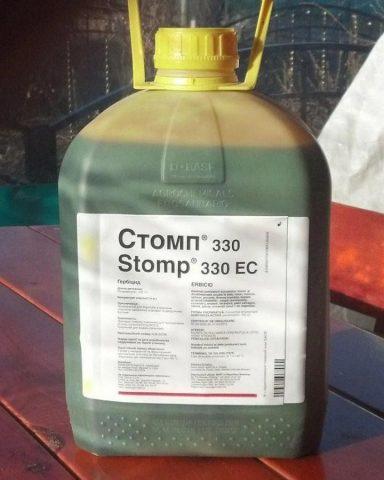Content
Weed control is an integral part of gardening and gardening work. Weeding beds by hand takes a lot of time and effort, so summer residents use specialized agrochemicals to destroy “undesirable” plants. Herbicides for garlic can also be used, but only in strict accordance with the instructions. Otherwise, after treatment, the cultivated plants will die, and hence the future harvest.
How to choose a herbicide
All herbicides are divided into two main categories. Their action can be:
- solid;
- selective.
Obviously, only selective herbicides are suitable for treating a bed where garlic shoots have already appeared. Their “legality” is no less important. All drugs that have passed official tests are included in a special state catalog.
When assessing the potential harm to the soil and the environment in general, it is necessary to take into account that herbicides suitable for treating garlic, penetrating into the weed tissue through the green mass, are destroyed on average in 2-4 days. For drugs that begin to “work” through the roots, the “decay” period is much longer.

Selective herbicides kill only plants from certain families
Herbicides for treating garlic against weeds
Gardeners who want to get rid of weeds in their garlic beds have a fairly wide selection of preparations. If you are in doubt about which herbicide is best, it is recommended to consult a specialist.
Goal
The active ingredient is oxyfluorene. Effectively destroys the vast majority of dicotyledonous annual weeds.
Garlic beds are cultivated when the “feathers” grow to 10-12 cm (the rosette at this point consists of 2-3 leaves). The optimal height of weeds is about 7 cm. Penetrating into tissues, the active substance “knocks down” many vital processes, including photosynthesis and ATP synthesis. It begins to act within 3-4 hours.
When planning to spray garlic with Goal herbicide, you need to consider the weather:
- efficiency decreases sharply at temperatures above 23 ° C and when spraying wet plants immediately after rain;
- within 2-3 days before the planned procedure it should be sunny, but not hot;
- after freezing or a sharp drop in temperature, you need to wait 5-7 days;
Only one treatment with Goal per season is allowed. After this, at least 60 days must pass before harvesting. The concentration of the solution is 8-10 ml per 10 l.

Goal for spraying garlic can be used in conjunction with other herbicides, with the exception of anti-cereals
Stomp
Efficiency is provided by pendimethalin. Its main purpose is the destruction of self-seeding dicotyledonous weeds. It is used in beds with winter garlic in the fall (1-2 days after planting) or in the spring. Works best in the temperature range 5-25 °C.
The concentration of the herbicide in the solution is 10-25 ml per 10 l. Before spraying, be sure to water the soil abundantly. The protective effect lasts for 3-4 months.There must be at least 40 days left before harvest.
Within 1.5-2 days, the liquid “impregnates” the surface layer of soil. When weed seeds in a garlic bed try to germinate, the active ingredient in the herbicide Stomp “inhibits” the synthesis of proteins necessary for cell division. The seedling dies in 3-5 days.

Stomp also works as a pesticide, protecting garlic from many pests that live in the soil and lay eggs there.
Totril
Herbicide based on ioxynil to protect winter garlic plantings. It is used against annual weeds in the spring at the stage of the 2-3rd true leaf.
When the active ingredient gets on the weeds, it causes disruptions in the process of photosynthesis. Plants begin to turn yellow and dry out within 2-3 days, and finally die after 1.5-2 weeks.
To spray beds with garlic, the drug is diluted with water in a concentration of 25-30 ml per 7 liters. The instructions provide two schemes for applying Totril for winter garlic:
- In two doses: in the phase of the 1st-2nd true leaf and after about 2-2.5 weeks during the massive growth of weeds.
- In four doses: in the first leaf phase and then three more times with an interval of 7-8 days.

Garlic should not be loosened for a week after applying the herbicide Totril.
Hurricane Forte
Herbicide from the glyphosate category. Used to control annual and perennial weeds. The maximum effect is obtained by “continuous” spraying with the solution in the fall, after harvesting. Destroys the above-ground part and root system, including root shoots.Once on plants, the herbicide Hurricane Forte is quickly “absorbed” into the tissue, “reaches” the growth points and “inhibits” them.
In spring, the drug can also be used on unoccupied areas. You need to wait until the cereal weeds form 4-5 leaves and grow to 15-20 cm in height. Otherwise, they will not “absorb” enough toxin. It is best to plant sow thistle in garlic plantings when the rosette size is 5-10 cm; bindweed - at the beginning of flowering.
A single treatment is carried out during the season. The concentration of the solution varies from 20 to 40 ml per 10 l.

Herbicide Hurricane Forte destroys not only the most “noxious” weeds (sow thistle, wheatgrass, bindweed), but also trees and shrubs
Targa Super
Contact anti-cereal herbicide based on chisalofop-P-ethyl. It can be used against weeds throughout most of the season, starting from the moment the second leaf forms. However, at temperatures above 27 °C, the efficiency decreases noticeably.
The concentration of the solution for spraying garlic plantings is 15 ml per 2-3 liters. A minimum of 30 days must pass before harvest. The drug is effective for 35-40 days.
Weed growth stops immediately after spraying. When the solution is absorbed into the tissue, it “stops” the biosynthesis of fatty acids. This is destructive not only for the “undesirable” plant, the “secondary growing” rhizomes also die.

The larger the “contact area” of the Targa Super herbicide solution with the green mass of the weed, the faster it dies
Lontrel Grand
The active ingredient of the herbicide is clopyralid. To protect garlic from weeds, it is used until they bloom at a temperature of 10-25 ° C. Suitable for the destruction of annual dicotyledonous and perennial root shoots.
Once on the weed, the herbicide is absorbed into the tissue and “moves” to the growth points, “inhibiting” them. At the same time, it causes “failures” in the process of cell division. After 3-4 days they turn yellow and wither; the “undesirable” plants die completely (including the roots) in 1-2 weeks.
No more than one spraying is carried out per season. The concentration of the solution is 30-50 g per 10 liters of water.

The use of Lontrel Grand herbicide for garlic is excluded during precipitation, strong winds, and frosts expected in the next 2-3 days.
Fusilade Forte
The active ingredient is fluazifop-P-butyl. The systemic herbicide is used to destroy annual and perennial weeds in garlic plantings; it is especially effective against wheatgrass. It is sprayed in the phase of the 3-4th true leaf and after another two weeks. If hot (from 27 °C) or dry weather has established, it is recommended to wait until using Fusilade Forte for greater effectiveness.
Penetrating into plant tissue, the herbicide “blocks” the mechanism of cell division and the formation of cell membranes. The first signs of loss of tone are observed after 2-3 days, death - within 1.5-2 weeks.
No more than two treatments are carried out per season. Herbicide concentration – 50 or 100 ml per 10 l. Garlic can be eaten no earlier than 30 days after spraying.

Herbicide Fusilade Forte for garlic treatment can be used in tank mixtures along with most fungicides
Gesagard
Herbicide based on prometrin. Used to protect garlic from annual weeds.Spraying is carried out in the phase of the 1st-2nd leaf of “uncultivated” plants or before germination. Working solution – 20-30 ml per 10 l.
The protective effect lasts for 2-3 months - the weeds die when the seeds try to germinate due to “inhibition” of the photosynthesis process. Existing plants die off within 4-7 days.

Gesagard herbicide remains effective after processing garlic, regardless of weather conditions
How to treat garlic with herbicides
The instructions for most selective herbicides provide for similar treatment schemes for beds with garden crops, including garlic. Precautionary measures to protect the “needed” plants and ensure your own safety are also practically the same.
Things to consider:
- The herbicide solution quickly loses its properties. The drug is diluted immediately before the procedure. In most cases, the “shelf life” does not exceed a day; later processing of garlic will be ineffective.
- A shelter is built for the garlic, providing reliable protection from drops of the herbicide solution getting on them.
- The bed is treated by spraying the solution from a sprayer or sprayer, supplying liquid under pressure of up to one and a half atmospheres. The use of “handicraft” herbicides is unacceptable. Piston type sprayers are also not suitable.
- When working with the herbicide, it is necessary to use a set of personal protective equipment and suitable clothing to minimize the risk of contact of the solution with the skin.

The “kit” includes rubber gloves, goggles, a respirator, closed waterproof shoes
What to do if garlic is burnt by herbicide
If the herbicide gets on garlic, it is necessary to “wash” the leaves as quickly as possible by pouring clean water on it from a watering can or hose with a splitter attachment. If the gardener takes a few minutes to shower, there is a high probability that the garlic was not harmed by the herbicide at all. Although here a lot depends on the drug used.
When “help” is delayed, the presence and degree of “severity” of chemical burns becomes obvious after 2-3 days. All garlic leaves affected by the herbicide are cut off with a sharp knife or scissors.
Then the affected plants are provided with abundant watering. The soil at the roots should be constantly well-wetted, but stagnation of moisture should not be allowed. If possible, change the substrate, raking away soil “contaminated” with herbicide from the head of garlic and adding fresh soil.
Over the next month, garlic is not fed. The ban applies to both purchased fertilizers and folk remedies. It is unknown what reaction the “contact” of the herbicide and the selected fertilizer will cause.
3-4 days after cutting off the leaves “burned” by the liquid, foliar feeding of garlic with immunomodulator drugs is carried out, having previously “tested” them on several plants. If there is no negative reaction within 2-3 days, they spray all the specimens affected by the herbicide. Such “poisoning” inevitably suppresses garlic’s immunity, making it more vulnerable to pathogenic microflora and insect pests.
Conclusion
Herbicides for garlic are an effective way to control weeds that do not require much “labor” from the gardener. However, the desired result can be achieved only if you choose the right drug and use it, strictly following the instructions given in the manufacturer's instructions. Particular attention is paid to its dosage in the working solution.








